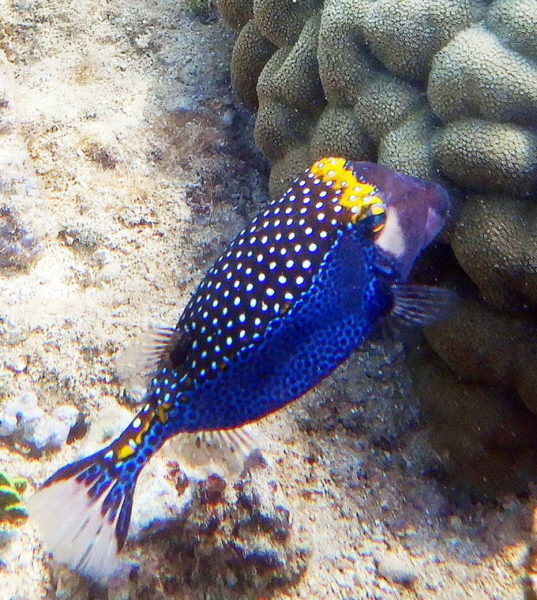Published in the Ocean Watch column, Honolulu Star-Advertiser © Susan Scott
August 17, 2019
Oahu artist Susie Anderson said in an email, “I was snorkeling the other day at Anini Beach on Kauai and spied the most unusual fish I’ve ever seen and wonder if you can identify it. No photos, but it looked like a puffer fish but the bottom half of the body was electric blue. The top half, black and white polka dots. What would be the forehead area had shocking yellow markings as well as on the tail. What a fish! Can you tell me what it was?”
Because this was one of my favorites when I was first learning Hawaii’s species, I knew which fish Susie saw before I even finished her description. Susie found a male spotted boxfish.
The boxfish gets its name from its suit of bony armor that encases the 6-inch-long body, similar to the steel-clad knights of old. The spotted boxfish’s armor consists of rigid plates so solidly fused that only the fish’s fins, eyes and mouth have the ability to move.
The spotted boxfish’s armor is squarish, hence the name, but other species in the family have three, four, five and even six sides.
You would think that the boxfish’s hard-to-swallow frame would be enough defense, but no. From the thin layer of skin covering the fish’s armor, these little fish, when threatened, secrete a toxin called ostracitoxin. The poison doesn’t harm humans, but an upset boxfish can be a disaster in an aquarium. The poison can kill fish tank-mates, and if stressed long enough, the boxfish will die from its own poison. Invertebrates in the tank don’t seem affected.
Female spotted boxfish are covered in polka dots. The attractive little fish are less flashy than their male counterparts, being blackish brown beneath their white spots.
Each male boxfish keeps several females to himself, fighting off other males with the nerve to raid the harem. Males fight over females by ramming one another, their armor making a noticeable bang when they hit.
When a male with a harem wants to mate, he nudges one of his females, which, if in the mood, will swim upward side-by-side with her partner while making a humming sound. In six seconds both fish have released their eggs and sperm, and the procreating is over — for the female. The male immediately goes back down to the harem to see whether he can entice another female into a romantic dash.
Boxfish look like slow swimmers but they’re surprisingly fast and agile, so much so that researchers have studied their fin movements as models for energy-efficient submarine designs.
Years ago, when we lived on our sailboat in the Ala Wai Boat Harbor, we had our own male boxfish that nibbled on the algae and tiny invertebrates growing on the hull. Seeing that beautiful little fish sculling along the boat’s waterline in the morning sun reminded me each day how lucky I was to be studying marine biology in Hawaii, and on a boat, no less.
Because the spotted boxfish represents the beginning of my love affair with ocean animals, to me the squarish fish is a brightly wrapped gift from the sea. Thank you, Susie, for the fond memory.
